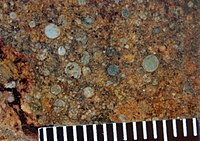
Photo from wikipedia
LL chondrite cooling histories require a ≥150-km parent body and accretion concurrent with LL chondrule formation. Chondritic meteorites, derived from asteroidal parent bodies and composed of millimeter-sized chondrules, record the… Click to show full abstract
LL chondrite cooling histories require a ≥150-km parent body and accretion concurrent with LL chondrule formation. Chondritic meteorites, derived from asteroidal parent bodies and composed of millimeter-sized chondrules, record the early stages of planetary assembly. Yet, the initial planetesimal size distribution and the duration of delay, if any, between chondrule formation and chondrite parent body accretion remain disputed. We use Pb-phosphate thermochronology with planetesimal-scale thermal models to constrain the minimum size of the LL ordinary chondrite parent body and its initial allotment of heat-producing 26Al. Bulk phosphate 207Pb/206Pb dates of LL chondrites record a total duration of cooling ≥75 Ma, with an isothermal interior that cools over ≥30 Ma. Since the duration of conductive cooling scales with parent body size, these data require a ≥150-km radius parent body and a range of bulk initial 26Al/27Al consistent with the initial 26Al/27Al ratios of constituent LL chondrules. The concordance suggests that rapid accretion of a large LL parent asteroid occurred shortly after a major chondrule-forming episode.
Journal Title: Science Advances
Year Published: 2020
Link to full text (if available)
Share on Social Media: Sign Up to like & get
recommendations!